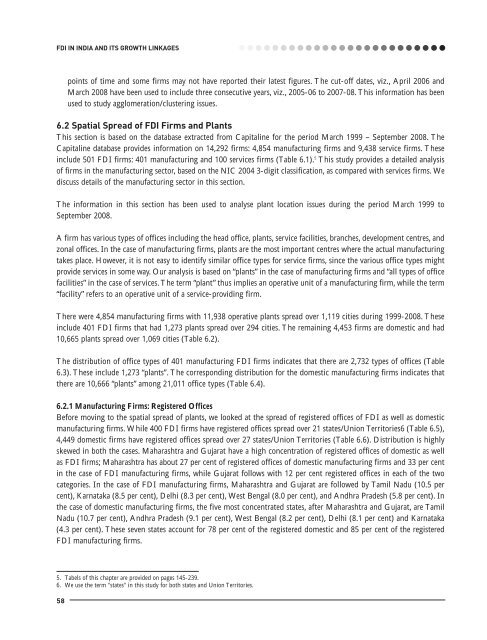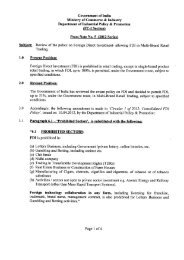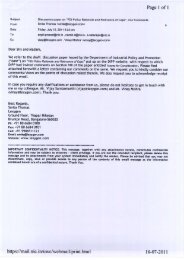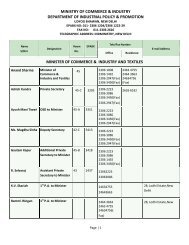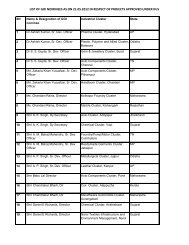fdi in india and its growth linkages - Department Of Industrial Policy ...
fdi in india and its growth linkages - Department Of Industrial Policy ...
fdi in india and its growth linkages - Department Of Industrial Policy ...
Create successful ePaper yourself
Turn your PDF publications into a flip-book with our unique Google optimized e-Paper software.
FDI IN INDIA AND ITS GROWTH LINKAGES<br />
po<strong>in</strong>ts of time <strong>and</strong> some firms may not have reported their latest figures. The cut-off dates, viz., April 2006 <strong>and</strong><br />
March 2008 have been used to <strong>in</strong>clude three consecutive years, viz., 2005-06 to 2007-08. This <strong>in</strong>formation has been<br />
used to study agglomeration/cluster<strong>in</strong>g issues.<br />
6.2 Spatial Spread of FDI Firms <strong>and</strong> Plants<br />
This section is based on the database extracted from Capital<strong>in</strong>e for the period March 1999 – September 2008. The<br />
Capital<strong>in</strong>e database provides <strong>in</strong>formation on 14,292 firms: 4,854 manufactur<strong>in</strong>g firms <strong>and</strong> 9,438 service firms. These<br />
<strong>in</strong>clude 501 FDI firms: 401 manufactur<strong>in</strong>g <strong>and</strong> 100 services firms (Table 6.1). 5 This study provides a detailed analysis<br />
of firms <strong>in</strong> the manufactur<strong>in</strong>g sector, based on the NIC 2004 3-digit classification, as compared with services firms. We<br />
discuss details of the manufactur<strong>in</strong>g sector <strong>in</strong> this section.<br />
The <strong>in</strong>formation <strong>in</strong> this section has been used to analyse plant location issues dur<strong>in</strong>g the period March 1999 to<br />
September 2008.<br />
A firm has various types of offices <strong>in</strong>clud<strong>in</strong>g the head office, plants, service facilities, branches, development centres, <strong>and</strong><br />
zonal offices. In the case of manufactur<strong>in</strong>g firms, plants are the most important centres where the actual manufactur<strong>in</strong>g<br />
takes place. However, it is not easy to identify similar office types for service firms, s<strong>in</strong>ce the various office types might<br />
provide services <strong>in</strong> some way. Our analysis is based on “plants” <strong>in</strong> the case of manufactur<strong>in</strong>g firms <strong>and</strong> “all types of office<br />
facilities” <strong>in</strong> the case of services. The term “plant” thus implies an operative unit of a manufactur<strong>in</strong>g firm, while the term<br />
“facility” refers to an operative unit of a service-provid<strong>in</strong>g firm.<br />
There were 4,854 manufactur<strong>in</strong>g firms with 11,938 operative plants spread over 1,119 cities dur<strong>in</strong>g 1999-2008. These<br />
<strong>in</strong>clude 401 FDI firms that had 1,273 plants spread over 294 cities. The rema<strong>in</strong><strong>in</strong>g 4,453 firms are domestic <strong>and</strong> had<br />
10,665 plants spread over 1,069 cities (Table 6.2).<br />
The distribution of office types of 401 manufactur<strong>in</strong>g FDI firms <strong>in</strong>dicates that there are 2,732 types of offices (Table<br />
6.3). These <strong>in</strong>clude 1,273 “plants”. The correspond<strong>in</strong>g distribution for the domestic manufactur<strong>in</strong>g firms <strong>in</strong>dicates that<br />
there are 10,666 “plants” among 21,011 office types (Table 6.4).<br />
6.2.1 Manufactur<strong>in</strong>g Firms: Registered <strong>Of</strong>fices<br />
Before mov<strong>in</strong>g to the spatial spread of plants, we looked at the spread of registered offices of FDI as well as domestic<br />
manufactur<strong>in</strong>g firms. While 400 FDI firms have registered offices spread over 21 states/Union Territories6 (Table 6.5),<br />
4,449 domestic firms have registered offices spread over 27 states/Union Territories (Table 6.6). Distribution is highly<br />
skewed <strong>in</strong> both the cases. Maharashtra <strong>and</strong> Gujarat have a high concentration of registered offices of domestic as well<br />
as FDI firms; Maharashtra has about 27 per cent of registered offices of domestic manufactur<strong>in</strong>g firms <strong>and</strong> 33 per cent<br />
<strong>in</strong> the case of FDI manufactur<strong>in</strong>g firms, while Gujarat follows with 12 per cent registered offices <strong>in</strong> each of the two<br />
categories. In the case of FDI manufactur<strong>in</strong>g firms, Maharashtra <strong>and</strong> Gujarat are followed by Tamil Nadu (10.5 per<br />
cent), Karnataka (8.5 per cent), Delhi (8.3 per cent), West Bengal (8.0 per cent), <strong>and</strong> Andhra Pradesh (5.8 per cent). In<br />
the case of domestic manufactur<strong>in</strong>g firms, the five most concentrated states, after Maharashtra <strong>and</strong> Gujarat, are Tamil<br />
Nadu (10.7 per cent), Andhra Pradesh (9.1 per cent), West Bengal (8.2 per cent), Delhi (8.1 per cent) <strong>and</strong> Karnataka<br />
(4.3 per cent). These seven states account for 78 per cent of the registered domestic <strong>and</strong> 85 per cent of the registered<br />
FDI manufactur<strong>in</strong>g firms.<br />
5. Tabels of this chapter are provided on pages 145-239.<br />
6. We use the term "states" <strong>in</strong> this study for both states <strong>and</strong> Union Territories.<br />
58


